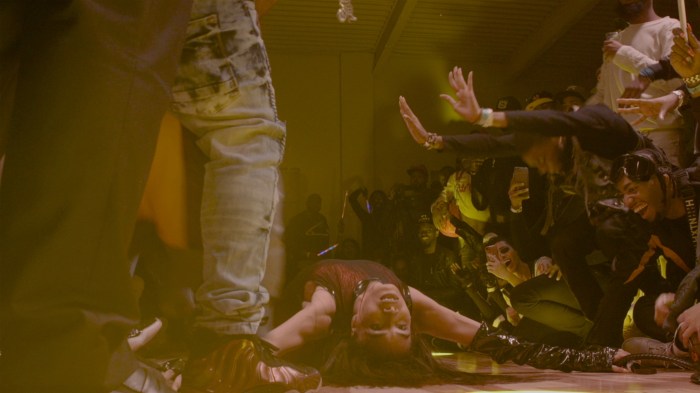French director Justine Triet’s “Anatomy of a Fall” has the shape of a mystery, but it’s an investigation into the dynamics of marriage rather than the whodunnit it resembles. While it’s not adapted from a novel or real-life case, it feels condensed from one. (It’s 2 and ½ hours long.) “Anatomy of a Fall” only makes glancing references to true crime in the form of a short clip of a talk show discussing accused killer Sandra’s (Sandra Hüller) case. Still, the trial-by-media numerous female celebrities have undergone and the rise in amateur sleuths dissecting women’s behavior are on its mind. Sandra’s skill as a novelist and freedom to sleep with both men and women get used against her once she’s on the stand.
After Daniel (Milo Machado-Graner) loses his sight in an accident, his parents’ relationship hangs on by a thread. Pressed to move to her French husband Samuel’s (Samuel Theis) hometown in the Alps, Sandra (Sandra Hüller) feels antsy. She has cheated on him within the past year. “Anatomy of a Fall” begins with her giving an interview to a student while Samuel tries to drown them out by blasting an instrumental version of 50 Cent’s “P.I.M.P.” at full volume on an infinite loop. Facing this aggressive gesture, she gives up on the interview. Hours later, Samuel’s body lies dead in the snow. In a possible suicide, the man fell from their house. A year later, Sandra stands trial, accused of his murder.
The audience doesn’t learn that Sandra is bi till the prosecutor (Antoine Reinartz) brings her sexuality up. He offers a bizarre interpretation of her interview in the opening scene as a seduction attempt. His imagination turns towards the lurid. Similarly, he interprets her novels as if they’re unvarnished recollections of her life rather than art informed by her own experiences. As sexist as he is, “Anatomy of a Fall” both shows how moments removed from a person’s life could look damning and scatters information from Sandra and Samuel’s marriage without giving us the full picture.
When first shown, Sandra’s interview sounds completely banal. Her remark that running makes her feel like she’s high on drugs, followed by the student asking “What do you know about drugs?, is obviously a flippant throwaway. Yet when she’s later suspected of staging a suicide attempt by poisoning her husband with an overdose, this could be seen to have sinister overtones. In fact, the interview was not an attempt at a seduction or a guarded confession, but it’s possible to take it — or many other moments of Sandra’s life — out of context and try to use it as evidence of villainy.
Triet and Arthur Harari’s script doles out information at regular beats. That’s the film’s weakest element: It feels as though the writers decided that the audience needs certain bits of information at an hour, then a new piece half an hour later, and so on. The decision to interrupt courtroom testimony with a flashback to Sandra and Samuel’s tense argument feels coy when it cuts the image just before a physical fight begins. Their anger is blisteringly raw and believable, creating one of the best scenes in a film you’ll see this year, but the decision to omit any evidence of who struck who is a manipulative conclusion.
The film’s ambiguity comes with the downside of relishing the fact that it knows more than the spectator. Sandra looks like a person with an ordinary set of flaws, while Samuel is completely unsympathetic. The courtroom scenes are stripped down, showing a documentary influence. (The title paraphrases Otto Preminger’s 1959 courtroom drama “Anatomy of a Murder.”) The drama of these scenes emerges in long scenes instead of being forced into “Law and Order”-ready shape, although the prosecutor is written as a rather one-dimensional villain.
Triet’s previous film, “Sybil,” explored attraction between women with a scattered tone and less impact, but it was preoccupied with the manipulation inherent in filmmaking. “Anatomy of a Fall” seems more confident, yet less honest than the more lurid impulses of “Sybil.” Her fourth feature, it won the top prize at Cannes last May. Still, both “Sybil” and “Anatomy of a Fall” leave a nagging sensation that Triet is torn between genre and arthouse impulses. Although the plot of “Anatomy of a Fall” is similar to the premise of Paul Verhoeven’s “Basic Instinct,” in which a bisexual female novelist is suspected of murder, its studied ambiguity and careful hints race away from this story’s pulpier connotations despite its lack of subtlety. “Anatomy of a Fall” wants to profit from flirting with the thriller without embracing it, and it almost gets away with it.
“Anatomy of a Fall” | Directed by Justine Triet | Neon | In French with English subtitles | Opens at the Angelika Oct. 13th, Film at Lincoln Center Oct. 18th































